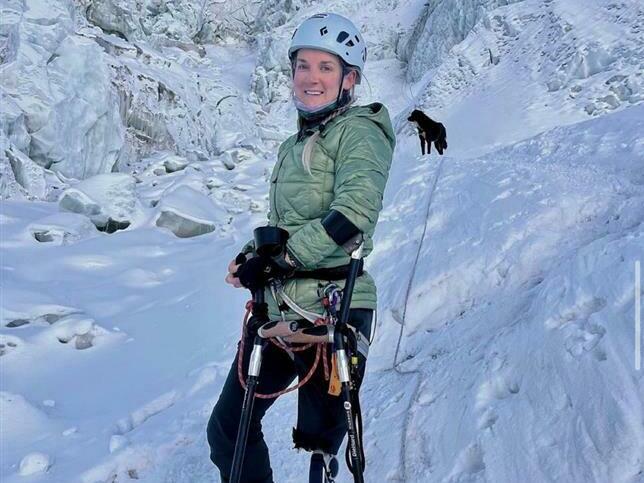Section Branding
Header Content
She was 200 meters from the peak of Mount Everest, then turned back. Here's why
Primary Content
Kirstie Ennis has scaled plenty of incredible mountains before. Here's why she decided to call it a day on her last journey.
Who is she? Ennis is a retired U.S. Marine Corps sergeant who was injured in a helicopter accident in Afghanistan in 2012 and lost her left leg. Since then, she's taken on adventure sports like mountaineering and snowboarding as her new challenge in life.
- Most notably, she has scaled six of the so-called "sevens summits" — the highest peaks on each of the seven continents.
- In 2019, she almost reached the peak of the big one — Mount Everest — when she was forced to turn back when her team's oxygen ran low.
- And last month, she came achingly close again.
What's the big deal?
- Things don't always turn out as planned, and in Ennis' case, that meant turning around last month after 43 days of climbing, when she was about 200 meters away from finishing.
- As an above-the-knee amputee who doesn't stop moving, Ennis is clearly far from a quitter. So why did she decide to call it a day?
What's she saying? Ennis sat down with NPR's Mary Louise Kelly to share what went into her decision, and why sometimes, knowing your limits is a victory in itself.
On why she decided to stop:
Well, this time around, it didn't make sense to continue going.
I pride myself on being able to put my team first, but also just self-preservation. And when I looked up, I was at the South Summit, and when I looked up at the line going into the summit, I realized that it wasn't worth it.
If something got sideways as far as my prosthetic limb or my prosthetic device, I didn't have the right team with me. And there were hundreds, literally hundreds, of people ahead of me and below me. So even if my 10-hour summit day was successful, [and] we didn't run out of oxygen or anything, it would still take me 24 hours to get down.
And so this time around there was a point where pride kind of got in the way, I was slightly embarrassed that I had to turn around. But at the same time, I'm very, very proud of the fact that I made that decision, because there are a lot of [other] people [climbing] that got hurt that night. I wouldn't be able to live with myself if anybody on my team got hurt.
Want more on sports? Listen to Consider This on how the PGA LIV golf deal is all about the green.
On scaling Everest with a prosthetic leg:
A lot of it really is just the way that my body moves. So I can't physically put foot over foot anymore, especially going on an incline.
So everything that I do now is essentially like taking a step with my right leg and then having to match it with my left leg. So my left leg is locked out at all times. There is no bending. I can only use it to brace or stabilize myself. There is no forward, or actually any kind of, momentum from my left leg whatsoever. And my biggest fear now when I'm out climbing these mountains isn't dying or running out of oxygen, any of those things. It's more so getting frostbite on my residual limb just because of the cold transferring so quickly through the aluminum and steel devices.
On what was going through her mind:
To be totally honest, I was heartbroken. I was devastated and heartbroken because I poured my heart into all of this.
I have worked so hard. I've climbed all around the world. I have gone through all sorts of different lessons, like certifications, qualifications. And I never really felt comfortable being called a mountaineer. I feel like that is such a prestigious title because it's something that so many people work their bums off for. And then this time around, what I saw on Everest, it wasn't mountaineers out there.
It was other individuals who shouldn't have been out there who were causing others to not be able to do what they have poured their soul into doing. So, I honestly came down, like I said, heartbroken, but there's a little bit of resentment there.
On seeing it as the right decision:
I felt all of the emotions around having to turn around, but also being proud that I made the right decision, that I came home to my family, that I still have all 10 fingers and five toes of mine. I can still climb. I could still see another day doing the thing that I love. I cried about it for the first time [Wednesday].
So, what now?
- After some much-needed recalibration, Ennis says she plans to conquer Everest next year, and is trying to decide whether to climb the north or south side. And she already has a new goal waiting for her once that's done:
- "I want to be the first amputee or above-the-knee amputee to swim the English Channel. I also want to do the Great Divide ride, which is a 2,600 mile transcontinental mountain bike ride. So essentially Canada to Mexico. And then I want to do seven marathons, seven continents in seven days [for] the World Marathon Challenge."
Learn more:
- Many teens don't know how to swim. A grassroots organization is trying to change that
- Tennis stars get lots of hate online. The French Open gave them AI 'bodyguards'
- Paraclimbing athletes hope for inclusion in the Paralympic Games
Copyright 2023 NPR. To see more, visit https://www.npr.org.

